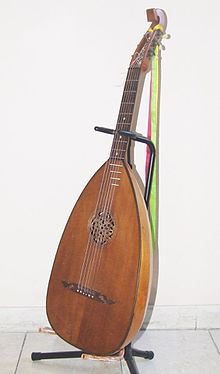Youth music movement

The youth music movement (often also the singing movement in the 1920s and 1930s ) was a musical educational direction influenced by the youth movement at the beginning of the 20th century . She endeavored to promote music-making among laypeople , including the maintenance of traditional folk songs .
One of the starting points was the rediscovery of the German folk song in the Wandervogel , which was written around 1900 . The songbook Der Zupfgeigenhansl , published by Hans Breuer , and a new musical instrument, the guitar lute, were widely used in the youth music movement . In addition, old and in some cases forgotten instruments experienced a revival in the Wandervogel movement , such as the recorder , the forest zither or the mandolin .
Personalities
- Hans Breuer
- Richard Goelz
- Georg Götsch
- Hans Grischkat
- Walther Hensel
- Reinhold Heyden
- Fritz Jöde
- Johannes Jehle
- Jens Rohwer
- Gottfried Wolters
- Eduard Zuckmayer
literature
- Fritz Jöde (Ed.): Musical youth culture. Suggestions from the youth movement. Hall, Hamburg 1918.
- Fritz Jöde: Music Manifesto. Greifenverlag, Hartenstein 1921.
- Fritz Jöde: Our musical life. Cancellation and start. Zwissler, Wolfenbüttel 1923.
- Walther Hensel : About the entire music care in schools and people (= German future. Contributions to rebirth from the spirit of youth. 1, ZDB -ID 2540848-3 ). Greifenverlag, Rudolstadt 1924.
- Hilmar Höckner: Youth Music in the Landerziehungsheim (= Die Musikanten-Gilde. Werkschriften der Musikantengilde. 1, ZDB -ID 541284-5 ). Kallmeyer, Wolfenbüttel 1926.
- Hilmar Höckner: The music in the German youth movement. Represented in terms of development history. Kallmeyer, Wolfenbüttel 1927.
- Annemarie wing: youth movement and youth music. Brief introduction to the development of the youth movement and youth music, with information on the relevant books, specialist journals and song collections. Steiger, Moers 1931.
- Reinhart Stephani: The German musical youth movement. Marburg 1952, (Marburg, University, dissertation, 1952; typed).
- Theodor W. Adorno : Dissonances. Music in the managed world (= Kleine Vandenhoeck series. 28/29, ZDB -ID 255845-2 ). Vandenhoeck & Ruprecht, Göttingen 1956.
- Reinhard Szeskus: The Finkenstein Movement. Leipzig 1966, (Leipzig, University, dissertation, 1966; typewritten).
- Ulf Jöde: The development of the song setting in the German youth music movement. Möseler, Wolfenbüttel et al. 1969, (At the same time: Hamburg, University, dissertation, 1969).
- Dorothea Kolland : The youth music movement. “Community Music” - Theory and Practice. Metzler, Stuttgart 1979, ISBN 3-476-00427-9 (also: Berlin, Technical University, dissertation, 1978).
- Wilhelm Scholz, Waltraut Jonas-Corrieri a. a. (Ed.): The German youth music movement in documents of its time from its beginnings to 1933. Möseler, Wolfenbüttel et al. 1980.
- Sigrid Abel-Struth (Ed.): Youth Movements and Music Education (= Music Education. Supplement. 2 = Scientific Society for Music Education. Meeting Report. 2). Schott, Mainz et al. 1987, ISBN 3-7957-1821-X .
- Karl-Heinz Reinfandt (Hrsg.): The youth music movement. Impulses and effects. Möseler, Wolfenbüttel et al. 1987.
- Klaus Peter Leitner: Hans Grischkat (1903–1977). A Bach interpreter of the youth music movement in Württemberg (= series of writings on cultural studies. 32). Kovac, Hamburg 2000, ISBN 3-8300-0122-3 (also: Tübingen, University, dissertation, 1999).
- Volker Jehle : Jehle, Johannes Albert Emil Traugott. In: Biographisch-Bibliographisches Kirchenlexikon . Volume 35: Supplements XXII. Bautz, Nordhausen 2003, ISBN 978-3-88309-882-1 , Sp. 608-625, (can also be read on the Internet).